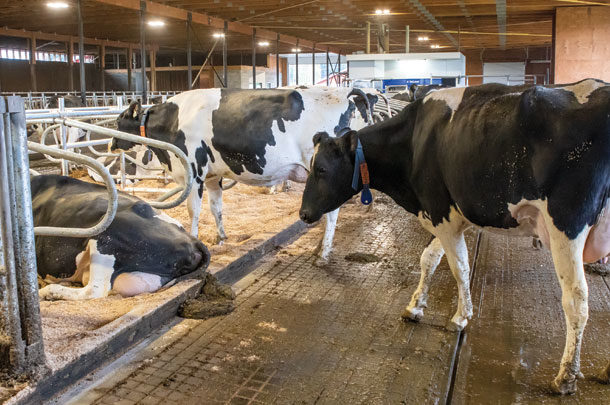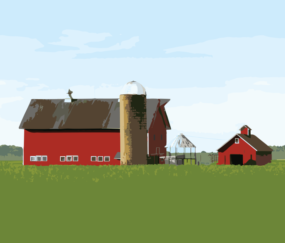Lameness is simply defined as “a symptom of pain.” Lameness is the third-most common reason for culling cows, after infertility and mastitis, and it is reported that 10% of dairy cattle are culled due to this affliction.
This article is designed to give insight to identify and assess lameness on your farm – from a “herd’s eye view.”
There are two classifications of lameness commonly seen among dairy cattle: leg issues or hoof issues. With 90% of all lameness occurring on hooves, the majority of lameness can be attributed to hoof diseases or other hoof issues. Leg issues account for the other 10% of all lameness. Luckily, general signs of lameness can be identified early to address or treat these issues right away.
Methods to assess for lameness in a herd or group
Scoring and assessing lameness is an opportunity to determine the percentage of issues, document benchmarks (pre- and post-assessments), note cows as high priority (to create a “treat” or “sick cow” list) and rate severity of issues (to track improvement). An accurate assessment of lameness in a group or herd is a necessary time investment. Choosing the right best suited to the reason behind the assessment is key to efficiency and proper tracking of issue severities. The following are three common methods of lameness assessment:
1. Observation
Good, old-fashioned cow observation by trained personnel can be time-consuming, but the level of accuracy can’t be beat. The downfall in this assessment method is in the potential lack of training of the observer, limited view of hooves or pure subjectivity when interpreting hoof conditions. Observation of lameness can be done in a parlor, from alleys or simply by walking around the barn. If you can see how a cow is walking or view the hoof for inspection, this technically qualifies as an observation method of assessment. For better accuracy, lifting hooves in a chute is going to give the best view inside hooves and the opportunity to see what’s really causing lameness.
To score a herd using observation
- Start with one group and walk through, ensuring each cow stands from its stall and walks.
- Make a list of cows that show signs of lameness, noting whether you suspect or visually see the cause.
- Document which foot is affected (i.e., back/front or left/right).
- Note cows with a severe issue or that may need immediate attention; for example, a cow that may not want to stand from a stall, with apparent lesions or a severe limp. A locomotion score may also be assigned while observing cows and taking notes.
This is the preferred method to use when you are looking for a benchmark (pre- and post- assessment) to identify the severity of issues, as it gives the most information and insight to the real issues. Although more time-consuming than other methods, with the right observer, it can be the most valuable.
2. Locomotion scores
When assessing a herd or group of cows, locomotion scores can give a good idea of general lameness; therefore, this is a common practice on farms to identify lame cows. Generally, a score of more than 2 on the scale of 1 through 4 is considered “lame.”
The method is a quick way to identify severe issues that need immediate attention in order to prevent lost profits and to be proactive in animal welfare. Locomotion scores are a quick assessment for the purposes of creating a list of cows to sort out from the herd and address in a chute.
The downfall of this method is: Some cows may have an issue arising or may not yet be displaying visible signs of lameness. Therefore, some cows may not get flagged or recorded in the assessment. Since this is a highly subjective scoring method based primarily on observation, the accuracy of percent lameness in a herd or group can be skewed. This method will give a general idea of the cows that may be less productive due to immobility; however, it may not always be most accurate when determining the percent lameness in a herd.
3. Technology
Hoof-trimming software
Most farms work with a hoof trimmer to keep track of both individual cow and overall herd hoof health. A standard service from many trimmers is to receive a report documenting lameness and treatments. This report can give valuable information to assess your herd’s hoof health and determine the effectiveness of the current hoof health program.
For dairies that have taken the hoof trimming task in-house, it is recommended to use computer software or an app to keep track of the cows trimmed and treated. Having a tablet mounted to the chute allows for easy tracking.
The key to in-house hoof trimming is to ensure farm personnel can provide the cows with the same professional maintenance and trimming routine as a hoof trimmer would.
Other lameness-tracking technology
There are a few more advances worth mentioning in regards to lameness-tracking technology.
The newest technology released, built into the flooring of robotic milking systems, is a sensitive scale with force sensors that can measure the weight balance of dairy cattle on each foot. In a nutshell, the scale is programed to find deviations from the centre of gravity for software to deduce that there is a hoof issue on a foot bearing less weight than normal. A new study released this year found that force sensors are able to detect sole ulcers and white-line disease more quickly than locomotion scoring; however, locomotion scoring can detect joint problems before force sensors.
Last, cameras with sensors can be installed in barns that track cow movements. Essentially, these cameras are enabling locomotion scoring remotely and digitally. This can be a cleaner, quicker way to track each individual cow; however, without a program to track the cow’s locomotion scores automatically, an observer will still have to score each cow. It may be difficult to see and flag lame cows on a small screen.
References omitted but are available upon request by sending an email to the editor.
Common signs of lameness
- Limping
- Favoring hooves (weight displacement or not setting hoof down)
- Foul smell (foot rot)
- Swelling
- Visual lesions
- Excessive lying down or immobility
- Hesitation to walk through a footbath
- Decrease in milk production and/or reproductive ability
- Weight loss
- Curved spinal cord (hunched)
- Poor stance/posture and gait













